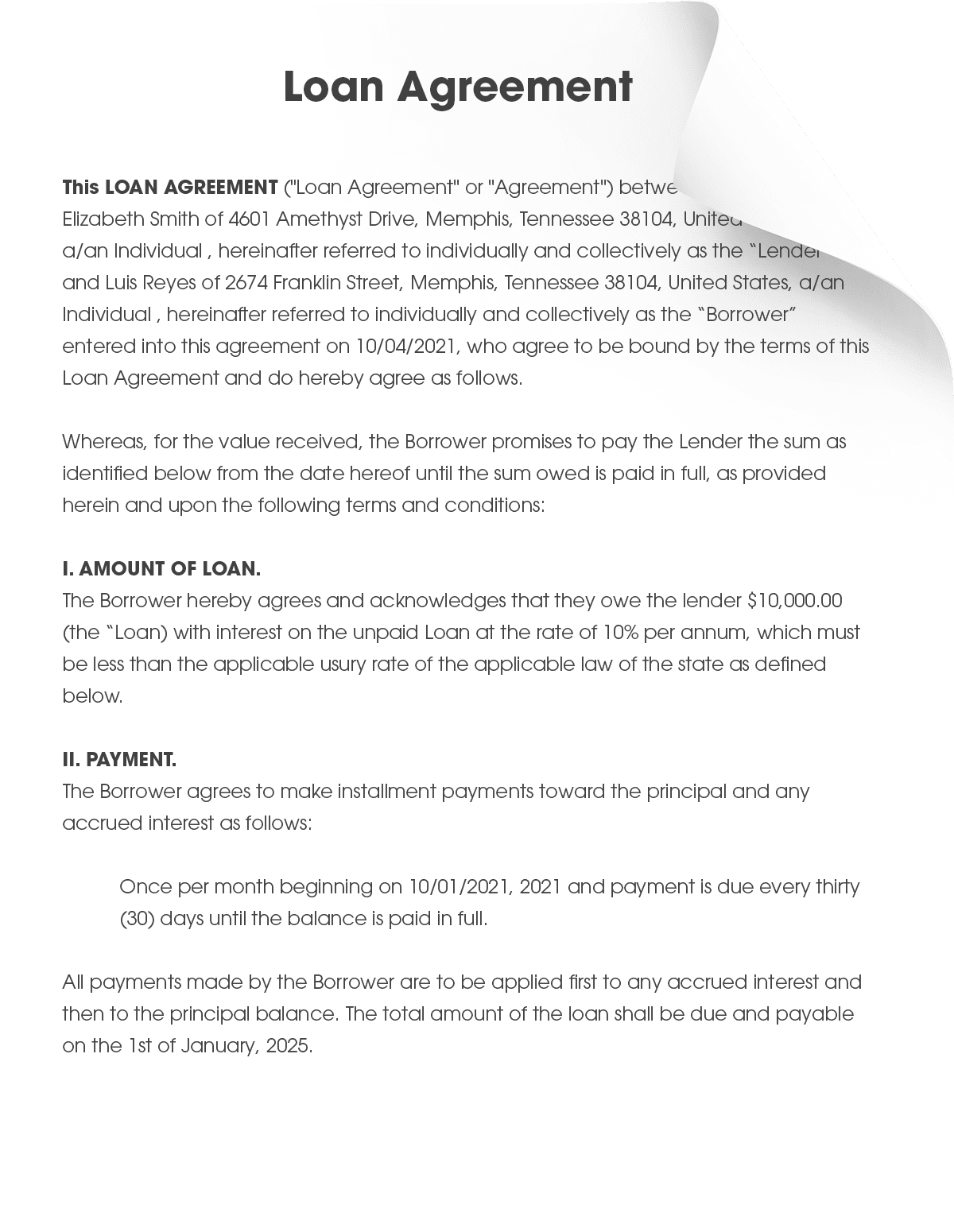What is a Loan Agreement and Why Do You Need a Free Printable Template?

A loan agreement is a document that summarizes the agreement that a borrower and lender have about a loan that is to be repaid. It can help create evidence of your agreement and be used to collect on the loan if the borrower defaults on repayment. The loan agreement includes the amount of money that is being loaned as well as establishing a payment schedule. Loan agreements can be used for various reasons, including a business loan, real estate loans, student loans, personal loans, and many more. Using a free loan agreement template can make the process much easier and quicker.
Why Do You Need to Use a Loan Agreement?
You should have a loan agreement if you lend someone you know money and expect to be repaid. A loan agreement form sets forth the terms of the contract between both the borrower and the lender. It specifies the loan amount, what the loan is for, and the payment schedule. The agreement protects the lender in the event the borrower defaults. The loan agreement template will implement a clear payment schedule that both parties are bound to.
When do you need to use a Loan Agreement?
A loan agreement can be used for many transactions. It can be utilized in a formal setting, such as a real estate purchase, or for an informal loan between family members. Using a loan agreement maker ensures the document is properly formatted and includes all necessary details.
How Can Having a Written Loan Agreement Help Me?
Having a written loan agreement can do the following:
- Make sure you are on the same page. Having a written agreement can help the lender and borrower have a clear understanding about the lending and repayment of money. This can help avoid confusion and conflict. If a court has to determine your agreement, it will be much easier when you have a document that clearly spells out the terms of your agreement.
- Make collecting the loan easier. A lender’s written agreement can describe their rights in case the borrower defaults, such as charging late fees or accelerating the loan. The court can only impose those penalties that are provided in your agreement.
- Pay for expenses. If it becomes necessary for the lender to pursue collection on the loan, a written agreement can instruct that the borrower has to reimburse the lender for collection or enforcement costs.
Are There Any Deadlines or Times When This Form is Needed?

A loan agreement should be drafted and agreed upon before the commencement of the loan. This protects the parties from any issues that should arise or discrepancies like what was discussed outside of the contract. It also allows the borrower(s) to review and agree to the repayment schedule and inquire about any interest that may be imposed. Using a loan agreement sample can guide you through the process.
Do I need to file my loan agreement anywhere?
No. However, you should keep the original loan agreement with your signature for your records, in case you ever need to present it to the court.
Do I Have to Charge Interest?
In the United States, there is no federal or state law explicitly requiring lenders to charge interest on a loan. However, there are regulations that impact interest rates, including minimum interest rules at the federal level and usury laws at the state level.
Federal Minimum Interest Rules
The IRS has minimum interest rules to prevent tax avoidance through interest-free loans. If a lender does not charge interest, the IRS may impute interest—meaning they assume interest was charged at a minimum rate and tax the lender accordingly. This applies primarily to loans between related parties, such as family members or business partners.
To comply with these rules, lenders should charge at least the Applicable Federal Rate (AFR) set by the IRS each month.
State Usury Laws and Interest Rate Caps
While no state mandates a minimum interest rate, most states regulate maximum interest rates to prevent usury (excessively high rates).
- 42 states and Washington, D.C. have caps on interest rates and fees for loans, typically with a median cap of 27% APR for loans around $10,000.
- Six states—Alabama, California, Idaho, South Carolina, Utah, and Wisconsin—do not have specific numerical interest rate caps but require that rates be “reasonable” or not unconscionable.
- Delaware and Missouri have no interest rate limits or prohibitions on unconscionability.
What this means for your Loan Agreement:
- You are not required to charge interest, but if you don’t, the IRS may apply imputed interest rules for tax purposes.
- If you do charge interest, make sure it complies with your state’s usury laws to avoid legal issues.
- Check the Applicable Federal Rate (AFR) to determine a minimum interest rate that aligns with IRS guidelines.
By understanding these rules, you can ensure that your loan agreement remains compliant while avoiding unintended tax or legal consequences.
What Information Should Be In My Loan Agreement?

Your loan agreement should include the following information, at a minimum:
- Borrower’s Name – The full legal name of the individual or entity receiving the loan.
- Borrower’s Address – The physical or mailing address of the borrower for contact and legal purposes.
- Lender’s Name – The full legal name of the individual or entity providing the loan.
- Lender’s Address – The lender’s physical or mailing address for correspondence and legal notices.
- The amount of money that is borrowed – The total principal amount loaned to the borrower.
- The percentage rate of interest to be charged – If applicable, the agreed-upon interest rate on the loan.
- The state whose law will govern the agreement – The jurisdiction that will regulate the loan terms and any legal disputes.
- The term of the loan – The total duration of the loan, specifying when full repayment is due.
- The frequency of payments on the loan – Whether payments are made weekly, biweekly, monthly, or another schedule.
- The method of how loan payments will be paid – Specifies whether payments are made via check, bank transfer, cash, or another method.
What Are the Most Common Mistakes to Avoid?
Be sure to include a payment schedule that you can manage. Evaluate the borrower(s) earnings and determine what they could handle as far as a payment plan. For example, sometimes, it is easier for a party to pay weekly instead of monthly. This will all depend on each borrower’s financial situation and the lender’s preferences.
If the lender decides to include any form of interest in the loan agreement, it is critical that they are familiar with their state’s usury laws. The interest rate is a fee paid by the borrower, which is a percentage of the principal amount borrowed. It is a form of security for the lender to take a risk as to providing a loan. Usury laws vary from state to state. They establish the maximum interest rate a lender can charge. The lender should not charge more than is authorized under the applicable law.
Do I Need to Use a Lawyer, Accountant or Notary Public to Help Me?
Assistance from professionals can ensure that you have a clear understanding of the transaction and your legal rights. A notary public can help verify the signature of the other party. An accountant can discuss how the transaction may affect you or describe potential tax consequences. A lawyer can explain special rules that apply to your state. Regardless, we’ve got you covered! Our experts created a loan agreement generator, including easy-to-answer questions to help generate a loan agreement for your unique purposes. Fill in the information on the loan agreement form and bring it to a notary to verify the signatures.
What is the easiest way to create a Loan Agreement?
Lucky you! The answer is simple, it’s here on FormPros! You can glide through the process worry-free and have your free loan agreement template in no time!
Why Use Our Loan Agreement Generator?
Our easy to use loan agreement maker makes the process quick. Just have your loan information ready, enter it in when prompted, and your loan agreement is created and ready to use. It’s not worth the risk to overlook a loan agreement and fail to have one. Now, there is no excuse not to when you have FormPros on your side customizing the way you do business.
Be sure to check out our budget-friendly subscription plan. You will have the ability to generate unlimited loan agreement samples tailored to your specific needs. FormPros is your hub for forms just like this one, and many more! Another form similar to a loan agreement, but a little less formal (usually between family), is a Promissory Note. We have that form ready for you as well; you can find it here!
FormPros Has You Covered
Simplify your paperwork with FormPros! From creating paystubs, W-2s, and 1099-NEC forms to generating LLC Operating Agreements and even voided checks, our easy-to-use platform has you covered. Save time, reduce errors, and handle your business documents with confidence. Start now and see how FormPros makes professional form generation fast, affordable, and hassle-free!
Loan Agreement FAQs
-
Can I modify a loan agreement after it has been signed?
Yes, but both parties must agree to any changes. The modifications should be documented in writing and signed by both the lender and borrower to be legally valid.
-
What happens if the borrower wants to repay the loan early?
Some loan agreements allow early repayment without penalty, while others may include prepayment penalties. It’s important to specify these terms in the agreement before signing.
-
Can I include collateral in my loan agreement?
Yes, you can secure a loan with collateral (e.g., a vehicle, property, or other assets). If the borrower defaults, the lender may have the right to claim the collateral as repayment.
-
Do I need a witness for my loan agreement?
While not always required, having a witness or notary public can help verify the authenticity of the agreement and may be beneficial in case of legal disputes.
-
What should I do if the borrower stops making payments?
You can send a formal demand letter outlining the missed payments and potential consequences. If the borrower still doesn’t pay, you may need to pursue legal action or engage a collections agency.
-
Is a verbal loan agreement legally enforceable?
While some verbal agreements can be legally binding, they are much harder to prove in court. A written agreement is always recommended to protect both parties.
-
Can a loan agreement be used for business loans?
Yes, loan agreements are commonly used for business financing, including loans between business partners, investors, or external lenders.
-
How do I determine a fair repayment schedule?
A repayment schedule should consider the borrower’s financial ability and the lender’s expectations. Weekly, biweekly, or monthly payments should be outlined clearly in the agreement.
-
What happens if the lender wants to transfer the loan to another person?
A lender can sell or assign the loan to another party, but this should be explicitly stated in the agreement, and the borrower must be informed.
-
Can I use a loan agreement for a one-time loan between friends or family?
Yes, a loan agreement can formalize informal loans between family or friends, ensuring clear terms and preventing misunderstandings.





